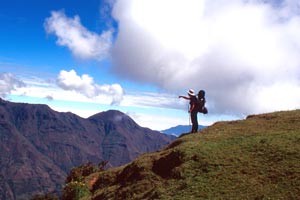 “Wayfarer, there is no path, you make the path as you go.”
“Wayfarer, there is no path, you make the path as you go.”
|
|
| English | Español | Deutsch | Français | Nederlands |
THE COUNTRY
- Why Ecuador?
- Slide Show
THE BOOK
- Foreword
- Preface
- Acknowledgments
- Table of Contents
- Trek Summaries
- Index
- About the Authors
- About the Publisher
A SAMPLE TREK
- Overview
- Route Description
- Topographic Map
- Elevation Profile
HOW TO BUY
THE BOOK
UPDATES
FEEDBACK
LINKS
CONTACT US
- The Authors
- The Publisher
© 2002-07 Kunstaetter
by Ben Box
Editor, South American Handbook.
 |
|
Overlooking the canyon of the Río San Nicolás. (Trek 27, Photo: RK) |
By South American standards, Ecuador is a small country. You only have to look at a map to verify that. Its compactness means that the visitor can cover a lot of ground and see a wide range of geographical regions in a relatively short time. This is especially true if you are using wheels.
This book, however, is not aimed at the bus passenger, the driver, or even the cyclist. Those who use it will be on foot, and anyone who sets out to trek in Ecuador will soon realize that it is a big country. This is not to imply that distances are unmanageable or that mountain slopes cannot be climbed—rather, that the individual will feel humbled by the majesty of the volcanoes, the variety of the forest habitats, and the longevity of the indigenous peoples' impression on this beautiful landscape.
The days of the idle vacation are long gone. People want more than the beach, or the bus trip from tourist site to tourist site. Their urge is to explore, to get closer to the country they are visiting. Robert and Daisy Kunstaetter have helped countless travelers realize ambitions of going beyond the beaten track. With this book, they concentrate on just one aspect of adventure tourism. They put treks in their proper context. They give the trekker the confidence to be completely self-sufficient if he or she so desires—or to choose a group led by experienced guides.
It may be obvious to state that trekking in Ecuador is not simply a question of packing a pan, buying a few bananas and a bottle of water in the market, and heading for the hills. You need to have the highways and biways at your fingertips: the best places to settle for the night, the best value for supplies, and the best location for the best advice. You also should have environmental and cultural awareness. In other words, this book is blunder-proof.
The secret of Robert's and Daisy's success lies in what, by their own admission, is their "notoriously leisurely" approach to trekking. Having traveled with Robert and Daisy in Ecuador—both on foot and by car—I can vouch for the merits of this approach firsthand. Why not make a detour down this track? Why not try this new flavor of ice cream from the shop on the corner? To quote the dictum of medieval educators, it is the spirit of "enseñar deleitando," imparting knowledge through enjoyment. If they did not take the time to pause, to look, to talk, to savor, they would not be able to communicate their enthusiasm for the intimate details that are to be found in this grand country.


